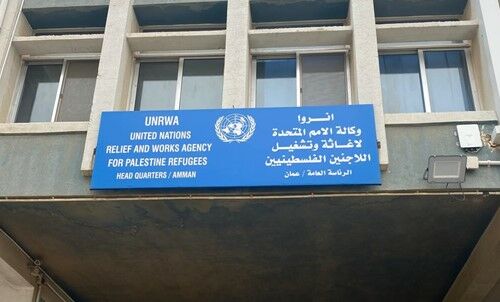Postcard from the field: GOARN deployment to support the health response in Gaza in 2024
Laura Paris, EPIET fellow at the Health Protection Surveillance Centre in Ireland (C2023), went on a GOARN deployment to support the health response in Gaza in 2024. This is her postcard from the field.

The EPIET programme provides fellows with a unique opportunity to conduct a field assignment overseas. On 20 November 2023, the United Nations Relief and Works Agency for Palestinian Refugees in the Near East (UNRWA) submitted a request for assistance from the Global Outbreak Alert and Response Network (GOARN) for an epidemiologist to support with disease surveillance, outbreak investigation, and data analysis in response to the war in Gaza, Palestine1. The following gives an account of my experiences during the deployment in Amman, from 10 March to 8 May 2024.
Since the start of the war on 7 October 2023, the United Nations (UN) estimates that 1.9 million people (90% of the population) in Gaza have been displaced (1). As reported by UNOCHA, the Palestine1 Ministry of Health had recorded 35 091 fatalities, and 78 827 injuries between 7 October 2023 and 8 May 2024. [1]. Health services continuously face ever mounting constraints, with only 12 of 36 hospitals partially functioning, and six of UNRWA’s 27 healthcare centres operational at the end of my deployment (8 May 2024) [2, 3].Internally Displaced Persons (IDPs) remain vulnerable to infectious diseases due to the destruction of infrastructure, limited access to clean water, poor hygiene, repeated displacement, and highly overcrowded living conditions [4]. Sanitation conditions in IDP shelters and the wider community are dire, with one toilet estimated for every 504 people and one shower for every 2 568 people, far exceeding Sphere emergency limits of a maximum of 20 [4]. Some people resorted to open defecation and consumption of contaminated water, further exacerbating disease spread [4].
As an epidemiologist, I contributed to enhancing the collection, analysis and reporting of infectious disease data at primary care level across the Gaza strip through UNRWA health centres and shelter medical points. This included the management and maintenance of UNRWA’s infectious disease dashboard monitoring 10 diseases of epidemic potential including polio and cholera, verifying alerts, and conducting risk assessments in close collaboration with the field team. I regularly presented UNRWA data at Health and WASH Cluster meetings to inform coordinated and targeted humanitarian responses. In addition, I was involved in UNRWA’s internal evaluation of the World Health Organization’s (WHO) Early Warning, Alert and Response System (EWARS) at its health facilities. This platform aimed to centralise infectious disease reporting across humanitarian actors for enhanced monitoring, streamlining information-sharing, and early detection of outbreaks, to elicit better informed and coordinated responses within the Health Cluster.
UNRWA initiated surveillance of infectious diseases of epidemic potential on 23 October 2023 using standardised case definitions defined by the WHO and the wider Health Cluster. An alarming and continuous surge in infectious diseases has been observed across all governates [3,4,5]. Acute hepatitis alerts have been issued, and there has been a large increase in the number of disease cases compared with the previous year. Although the population sizes (i.e. the denominators for the data) are different between the two years, with the 2022 data representing the whole population and the 2023 data excluding people in the Northern Region, the data show a large increase in cases in 2023, highlighting the seriousness of the situation. For instance, in the period between epidemiological weeks 43 and 52 (i.e. 23 October and 31 December 2023), the incidence of non-bloody diarrhoea increased by 33 times among children younger than five years and by 99 times among individuals aged five years and older compared with the same period in 2022.
Bloody diarrhoea and impetigo have seen dangerous increases over the same period (22 times and four times, respectively), underscoring the gravity of the health emergency [4]. The impact of these diseases is further exacerbated by the high levels of food insecurity and malnutrition, which are severe and widespread. By 15 February 2024, 96% of the population faced crisis or worse levels of food insecurity (Integrated Food Security Phase Classification, IPC 3 or above) including 745 000 facing emergency levels (IPC Phase 4) and 495 000 facing catastrophic levels (IPC Phase 5) [2,6]. In February 2024, the United Nations International Children’s Emergency Fund (UNICEF) reported that between 10% (Rafah) to 31% (Northern Region) of children under two years old were acutely malnourished.[7]
Despite the efforts of humanitarian health responders, the health of people living in Gaza continued to deteriorate. At the end of my deployment, the situation worsened with the onset of a ground incursion in Rafah, which was hosting over 1.8 million IDPs at the time [3,6]. This resulted in further destruction of healthcare and civilian infrastructure, the evacuation of international aid workers, and the re-displacement of people. During the short deployment, the UNRWA team experienced the loss of a colleague whose home was hit by missiles in Rafah. By the end my deployment, a total of 186 UNRWA staff had died since the start of the conflict [9].
The population of Gaza faced acute malnutrition and diseases that could be easily treated with a functioning health system. UN agencies and humanitarian actors call for an immediate humanitarian ceasefire in order for safe, unimpeded and sustained access to urgently deliver multi-sectoral humanitarian assistance.
1 This designation shall not be construed as recognition of a State of Palestine and is without prejudice to the individual positions of the Member States on this issue.
References
- World Health Organization (WHO). Gaza United Health Dashboard. 2024. Version 1.5. Microsoft Power BI
- United Nations Office for the Coordination of Humanitarian Affairs (UNOCHA). (2024). Reported impact snapshot | Gaza Strip (28 August 2024) | United Nations Office for the Coordination of Humanitarian Affairs (ochaopt.org)
- United Nations Relief and Works Agency for Palestinian Refugees in the Near East (UNRWA). 2024. UNRWA Situation Report #132 on the situation in the Gaza Strip and the West Bank, including East Jerusalem | UNRWA
- Al-Jadba G, Zeidan W, Spiegel PB, Shaer T, Najjar S, Seita A. UNRWA at the frontlines: managing health care in Gaza during catastrophe. Lancet. 2024 Feb 24;403(10428):723-6.
- Taha AM, Mahmoud H, Nada SA, Abuzerr S. Controlling the alarming rise in infectious diseases among children younger than 5 years in Gaza during the war. Lancet Infect Dis. 2024 Apr;24(4):e211.
- Integrated Food Security Phase Classification (IPC). 2024. IPC_Gaza_Strip_Acute_Food_Insecurity_Feb_July2024_Special_Brief.pdf (ipcinfo.org)
- UNICEF. (2024). Acute malnutrition rates double in one month in north Gaza (unicef.ie)
- United Nations Office for the Coordination of Humanitarian Affairs (UNOCHA). (2024). Humanitarian Situation Update #179 | Gaza Strip [EN/AR/HE] | OCHA (unocha.org)
- UNRWA Situation Report #107 on the situation in the Gaza Strip and the West Bank, including East Jerusalem | UNRWA







